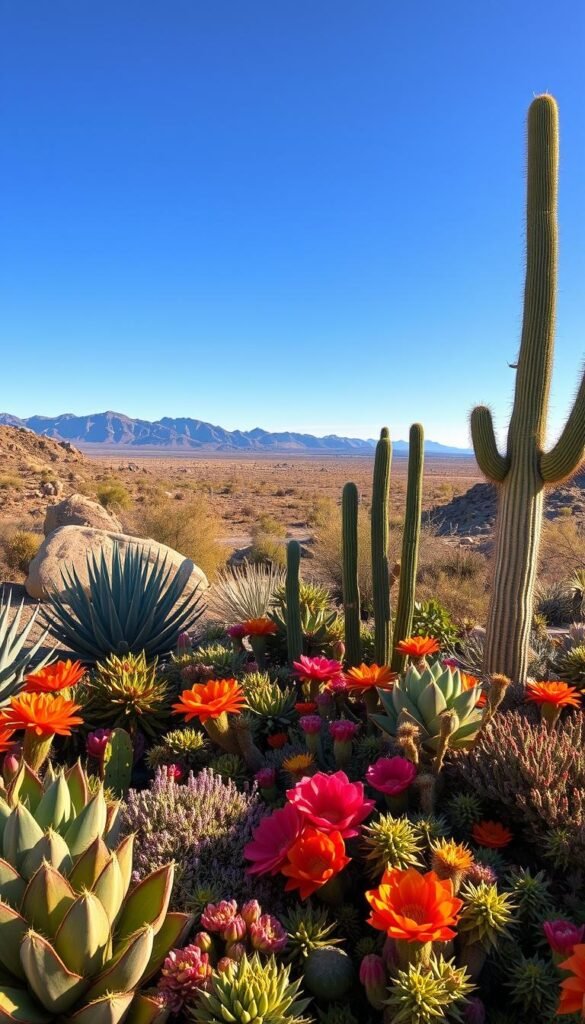Living in arid climates doesn’t mean sacrificing beauty in your outdoor space. Many resilient species thrive where others struggle, creating striking landscapes that demand minimal water. These natural survivors boast unique features—think silvery leaves, fleshy stems, or deep-reaching roots—that help them flourish under intense sun and poor soil.
Water-wise landscaping isn’t just practical—it’s packed with personality. Picture sculptural agaves standing beside spiky yuccas, their bold shapes contrasting with delicate blooms that pop against sandy backdrops. This approach celebrates texture and form while slashing maintenance time, letting you enjoy your yard without constant upkeep.
Want color without the hassle? Consider low-maintenance flowers that work well in raised beds or rocky terrain. Plants like blanket flowers and yarrow bring vibrant hues to your space while needing barely any attention once established. Their toughness makes them perfect for busy homeowners or those new to dry-climate gardening.
By embracing these strategies, you’ll create an outdoor oasis that’s both eye-catching and eco-friendly. Smart plant choices reduce water bills, support local ecosystems, and prove that thriving gardens don’t require endless resources—just thoughtful design.
Welcome to Your Desert Garden Journey
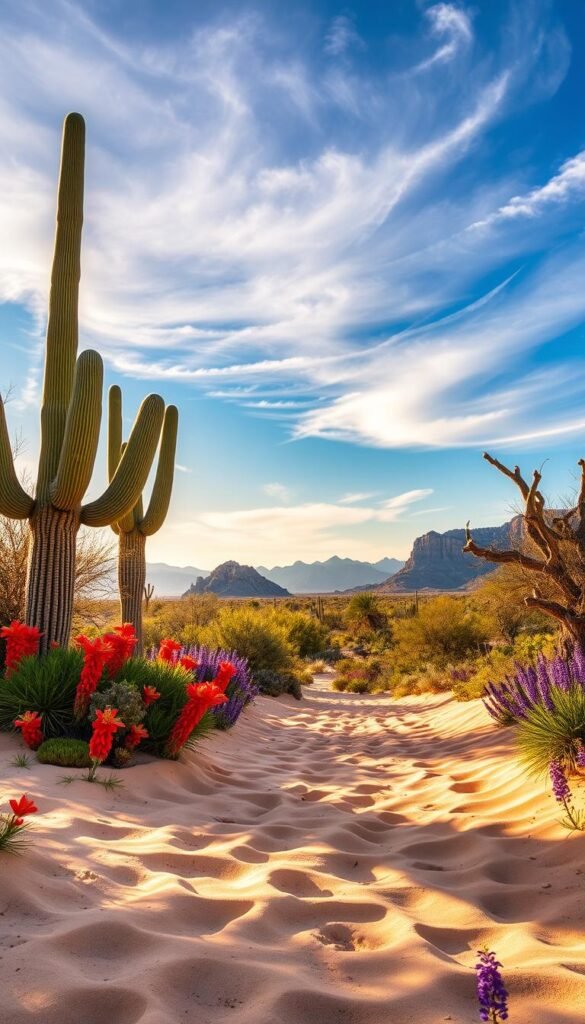
Your journey to a water-wise yard combines artistry with ecological mindfulness. Imagine crafting a space where plants don’t just survive—they dazzle with unexpected textures and colors. This approach celebrates nature’s ingenuity while cutting your water use by up to 60% compared to traditional lawns.
Forget struggling with high-maintenance flowers that wilt under intense sun. Hardy species like purple sage or red yucca offer year-round interest with minimal fuss. Their sculptural forms create living art that changes with the seasons, proving beauty thrives even in challenging conditions.
You’ll discover more than just a pretty landscape. These resilient growers support local wildlife and improve soil health over time. Every choice becomes a conversation with your environment—a balance of visual impact and practical sustainability.
Ready to start? Begin by observing how sunlight moves across your space. Note where shadows fall and which areas bake in afternoon heat. This simple step helps match plants to their ideal spots, setting your garden up for success from day one.
Understanding Desert Climates and Garden Design
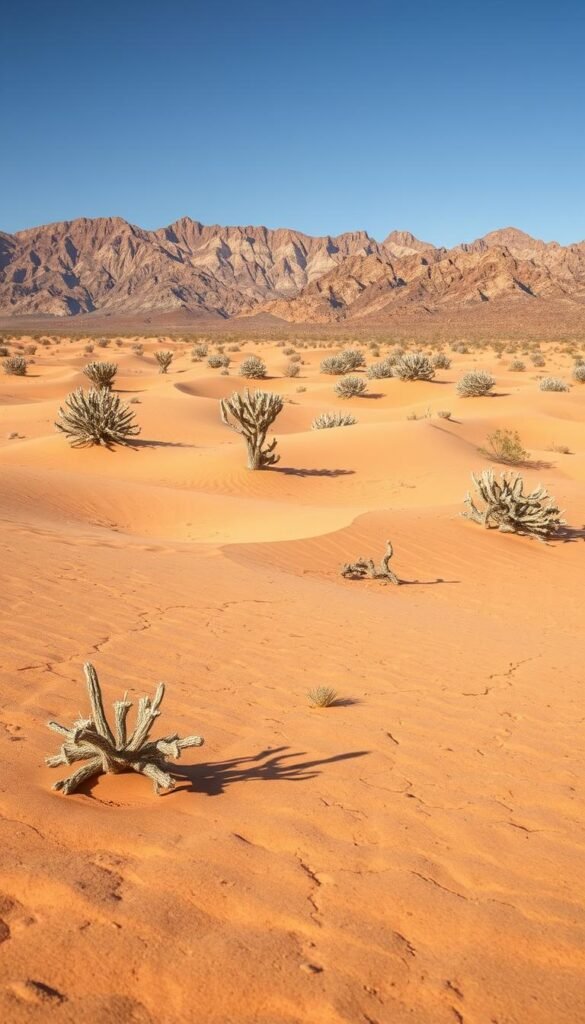
Crafting a resilient landscape starts with decoding your environment’s DNA. These regions aren’t just “dry” – they’re dynamic systems where soil composition and weather patterns dance in delicate balance.
Hot, Dry Areas: Climate Insights
Daytime temperatures often swing 40°F between dawn and midday. This rollercoaster stresses plants that can’t handle rapid changes. Three key factors shape survival here:
- Solar radiation intensity that bleaches untreated wood in months
- Rainfall events clustered in brief, unpredictable bursts
- Nighttime cooling that triggers dew formation on clever plants
Microclimates matter more than you’d think. A south-facing rock wall creates oven-like conditions, while shaded north slopes offer respite from heat extremes.
Soil, Water, and Drought Essentials
Dig a test hole – what you find determines your strategy. Sandy earth drains too fast, while clay acts like concrete when dry. The sweet spot? Loamy mixtures amended with:
- 3″ of compost to boost nutrients
- Pumice for aeration in heavy soils
- Mulch layers to mimic natural ground cover
Smart irrigation means watering deeply but infrequently. “Train roots to hunt moisture by letting soil dry between soakings,” suggests a Tucson master gardener. This builds drought resilience while preventing rot.
Exploring Drought-Tolerant Blooms
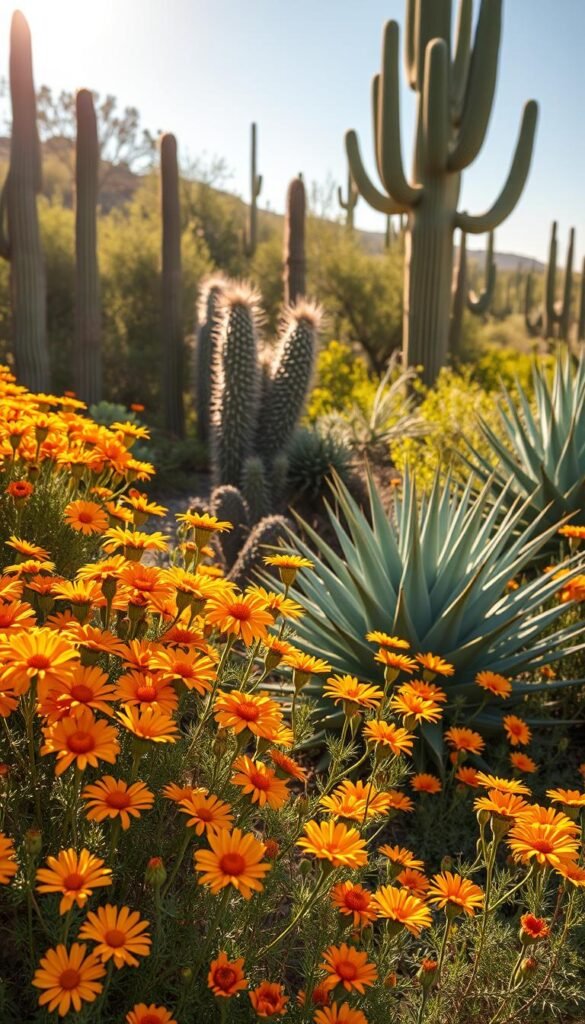
Transform your landscape into a vibrant tapestry with plants that thrive on neglect. These natural marvels deliver show-stopping displays while sipping water, proving beauty and resilience go hand-in-hand.
Architectural Wonders With Hidden Gems
Agaves steal the spotlight with their geometric perfection—250+ varieties offer spiky silhouettes in hues from steel-blue to variegated cream. But wait until their towering flower stalks erupt! Aloes counterbalance with softer curves, their 650+ species bursting into fiery red or sunny yellow blooms when least expected.
Nature’s Calendar of Color
Plan year-round interest by understanding growth cycles. Spring explodes with golden desert marigolds, while summer brings heat-loving penstemons. As fall arrives, purple trailing lantana takes center stage. Many species time their floral shows to brief rainy periods, creating ephemeral magic.
Pro tip: Mix evergreen succulents with seasonal flowers for nonstop appeal. A blue agave surrounded by autumn sage ensures something’s always putting on a show, whether through structure or blossoms.
Desert-Inspired Flower Garden: Drought-Tolerant Blooms for Hot, Dry Areas
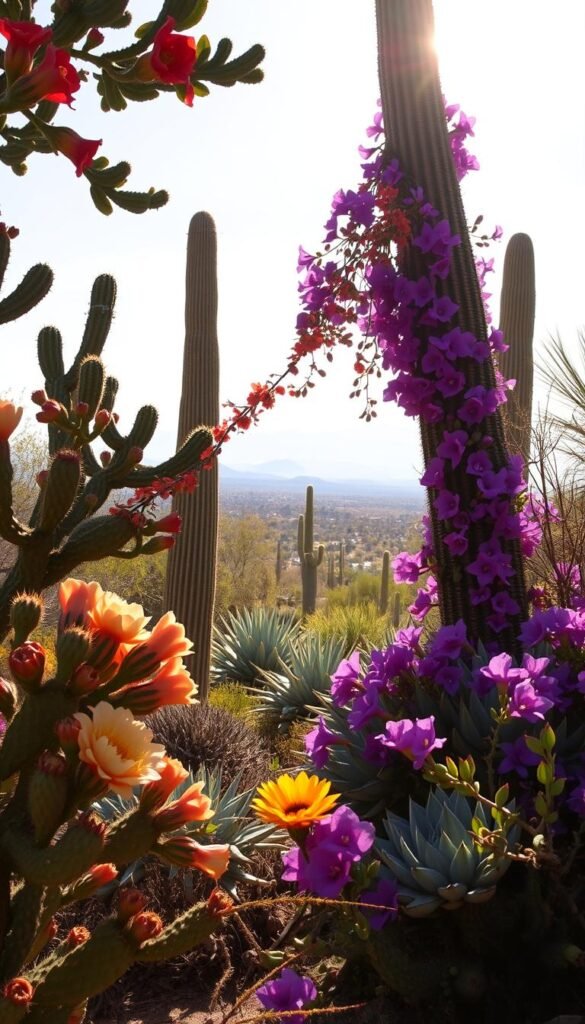
Building a resilient outdoor space starts with smart layering. Combine spiky cacti with airy shrubs and flowering ground covers to create depth that catches the eye. This approach mimics natural ecosystems where different plants support each other through shade sharing and moisture retention.
Add pops of color with native wildflowers like the California poppy. Its fern-like leaves contrast beautifully with succulent textures, while cup-shaped flowers in sunset hues brighten rocky spaces. “Pairing structural plants with soft blooms creates balance,” notes Arizona landscaper Maria Torres. “It’s like nature’s own art installation.”
Three essentials for success:
- Group species with similar water needs to simplify irrigation
- Use taller varieties to shelter delicate sun-loving varieties below
- Leave space between specimens for mature growth
Your garden becomes a living mosaic when you mix heights and bloom times. Silver-leaved shrubs reflect sunlight, keeping roots cool. Seasonal performers like penstemons add surprise bursts of color after rare rains.
Remember: even tough native species need smart placement. Observe how shadows move across your yard to match each plant’s light preferences. This thoughtful planning ensures your landscape stays vibrant through summer’s peak while conserving precious resources.
Selecting Full Sun and Warm-Weather Plants
Sunlight becomes your greatest ally when crafting a vibrant outdoor space. Certain species transform solar energy into dazzling displays, their colors intensifying under cloudless skies. The key lies in choosing varieties that thrive when others wilt—nature’s built-in sunscreen makes these selections shine.
Maximizing Sun Exposure for Vibrant Growth
Bougainvillea steals the show with papery bracts in neon pink and tangerine hues. This sun worshiper blooms nearly year-round in warm climates, climbing trellises or spilling over walls. “Position it where it gets morning-to-afternoon light,” advises Phoenix landscaper Carlos Mendez. “The more sun, the brighter the color explosion.”
Pair bold bloomers with structural grasses like Little Bluestem. Its blue-green blades shift to copper tones in late summer, topped by wispy seed heads that catch the light. This prairie native handles baking temperatures while adding movement to your design.
| Plant | Sun Needs | Peak Season | Design Role |
|---|---|---|---|
| Bougainvillea | 8+ hours | Year-round | Vertical color |
| Little Bluestem | 6-8 hours | Summer-Fall | Textural contrast |
| Red Yucca | Full sun | Spring-Fall | Architectural focus |
Smart placement matters. Use taller plants to cast afternoon shade on delicate neighbors. South-facing slopes work best for heat lovers, while east exposures suit those needing gentle morning light. Observe your space through the day—note where shadows fall during peak heat hours.
Remember: Full sun doesn’t mean no water. Deep, infrequent soakings train roots to access moisture belowground. Combine this strategy with gravel mulch, and watch your solar-powered paradise flourish.
Choosing Shrubs, Perennials, and Cacti with Curb Appeal
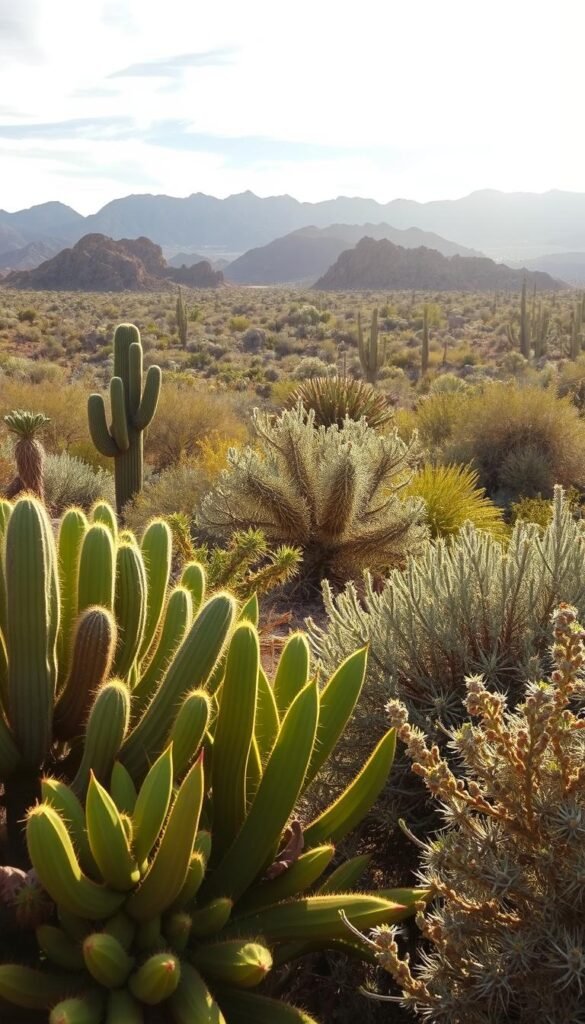
Your front yard deserves showstoppers that work smarter, not harder. Strategic plant choices create instant visual impact while slashing water bills and upkeep time. Let’s explore how to blend rugged charm with street-side elegance.
Architectural Succulents and Bold Perennials
The Joshua Tree makes a striking centerpiece with its twisted branches and spiky foliage. This living sculpture grows slowly but commands attention year-round. Pair it with the Creosote Bush—a versatile shrub offering yellow spring color and fluffy winter seed heads.
For layered interest, mix heights and textures. Try this combo:
| Plant | Height | Key Feature | Care Level |
|---|---|---|---|
| Joshua Tree | 15-30 ft | Sculptural form | Low |
| Creosote Bush | 3-6 ft | Four-season interest | Very low |
| Red Yucca | 2-4 ft | Summer blooms | Moderate |
Perennials like penstemon add reliable pops of color without replanting. Their tubular flowers attract hummingbirds while complementing succulent textures. “Group three of the same variety for maximum curb appeal,” suggests New Mexico landscaper Lila Rodriguez.
Remember: Space plants for their mature size. Rocky mulch between specimens reduces weeds and mimics natural habitats. Your drought-smart landscape will turn heads while thriving on neglect.
Incorporating Rock Gardens and Xeriscapes
Stone and plants unite to create landscapes that thrive on minimal care. Strategically placed boulders and gravel become the backbone of your design, supporting resilient greenery while cutting water use. These arrangements mirror natural desert ecosystems, blending rugged beauty with practical sustainability.
Using Texture and Stone Elements
Mix rough granite slabs with smooth river rocks to add depth. Decomposed granite forms a stable base for succulents like Rock Purslane, whose magenta flowers spill over edges from spring through fall. “Local stones anchor designs to regional character,” notes Colorado landscaper Eli Martinez. “They also regulate soil temperature for root protection.”
Three stone strategies for success:
- Use vertical boulders to create shaded pockets for delicate species
- Edge pathways with flat flagstone to define spaces
- Spread pea gravel between specimens to suppress weeds
Rock Purslane shines as a ground cover, its fleshy leaves contrasting with stone surfaces. Pair it with spiky agaves for tactile drama, or let it cascade over retaining walls. These combinations prove that low-water gardens can dazzle without constant attention.
Attracting Pollinators and Wildlife
Turn your outdoor space into a buzzing sanctuary by welcoming nature’s hardest workers. Choosing the right plants creates a thriving ecosystem where winged visitors fuel your landscape’s vitality while adding dynamic movement to your design.
Nature’s Frequent Flyers
Hummingbirds flock to trumpet-shaped flowers like those on Mexican Bird of Paradise. Its fiery orange-red clusters act as neon signs for these tiny speedsters. Pair it with Chitalpa’s fragrant pink blooms—their snapdragon-like shape offers perfect butterfly landing pads from spring through summer.
Bees prefer single-petaled varieties where pollen’s easily accessible. Try globe mallow or penstemon, whose open faces let pollinators work efficiently. Space these nectar sources in staggered groups to form natural flight paths between feeding stations.
Pro tip: Leave some bare ground between rocks for ground-nesting bees. A mix of flowering seasons ensures your winged guests never go hungry. Watch as your yard becomes a living network of energy exchange—beauty and purpose working hand-in-wing.

